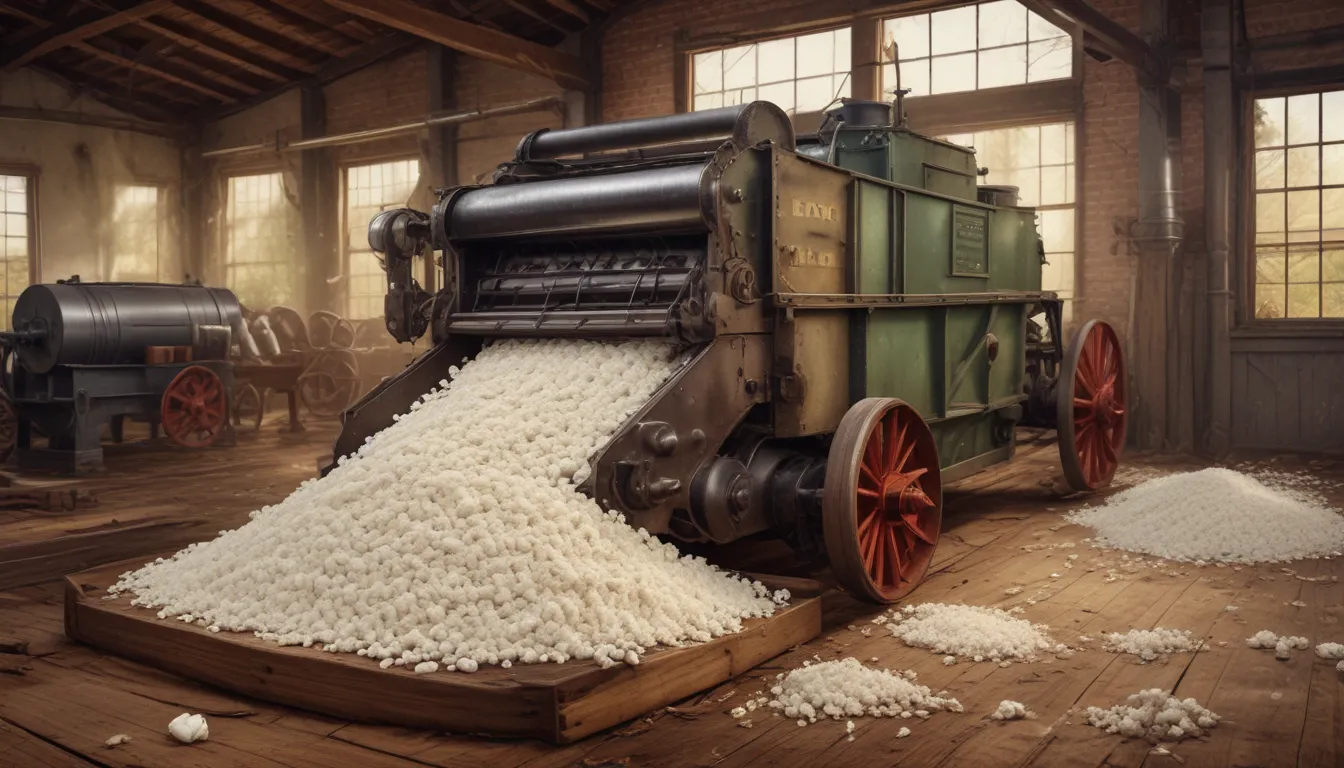The images in our articles may not match the content exactly. They are used to grab your attention, not to show the exact details in the text. The images complement the text but do not replace it.
Have you ever stopped to think about how a single invention could completely revolutionize an entire industry? The cotton gin did just that, reshaping the cotton industry and leaving a lasting impact on history. But what exactly is a cotton gin, and why is it considered such a game-changer? This device transformed the way cotton was processed, making it faster and easier to separate cotton fibers from their seeds. This seemingly simple mechanism had far-reaching effects, from boosting cotton production to altering social and economic structures. Get ready to uncover some of the most fascinating facts about the cotton gin, shedding light on its significance and the ripple effects it created worldwide.
Unveiling the Cotton Gin: A Game-Changing Invention
The cotton gin, with its roots in 1793 when Eli Whitney invented it, revolutionized the cotton industry by streamlining the process of separating cotton fibers from their seeds. The term “gin” itself is derived from “engine,” signifying the mechanical process of this separation. Before the cotton gin, separating cotton fibers from their seeds was a labor-intensive task that could take an entire day for just one pound of cotton. However, with the introduction of modern cotton gins, thousands of pounds of cotton can now be processed in a single day, showcasing a monumental leap in efficiency and productivity.
The Economic Influence of the Cotton Gin
The invention of the cotton gin had a profound impact on the economy of the American South, leading to cotton’s dominance as a key crop and export. The gin’s efficiency made cotton farming immensely profitable, resulting in the expansion of cotton plantations. However, this profitability also led to an unfortunate rise in the demand for slave labor, as plantation owners sought to maximize their cotton production. By the mid-19th century, cotton accounted for about 60% of all American exports, thanks in large part to the cotton gin.
Continuous Innovation and Advancements
Since its inception, the cotton gin has undergone multiple advancements to boost efficiency and reduce labor requirements. Early versions of the gin were hand-cranked, but later iterations were powered by animals, water, or steam. Present-day cotton gins are highly automated, capable of separating seeds from cotton fibers much more swiftly and effectively than their predecessors. Innovations in cotton gin technology have also focused on minimizing damage to cotton fibers during the ginning process, ensuring higher-quality cotton is produced.
Environmental and Social Consequences
While the widespread use of the cotton gin had significant environmental and social implications, not all were positive. The expansion of cotton farming led to notable deforestation and soil depletion in various parts of the American South. Additionally, the reliance on slave labor for cotton farming and ginning operations is a somber reminder of the social costs associated with agricultural advancements. In recent times, there has been a push towards more sustainable cotton farming practices, including the development of energy-efficient and eco-friendly cotton gins.
The Ever-Present Cotton Gin in Today’s World
Even in modern times, the cotton gin remains an integral part of the cotton industry, though the machines and their operational contexts have evolved significantly. Portable cotton gins now allow for on-site ginning in remote farming areas, reducing transportation costs and enhancing efficiency. Genetic modifications to cotton plants have made fibers easier to gin, reducing strain on machines and improving final product quality. Despite technologically advancements, the core principle of the cotton gin—separating cotton fibers from their seeds—has remained unchanged since Eli Whitney’s era.
Reflecting on a Revolutionary Invention
The legacy of the cotton gin is a testament to human ingenuity and its power to reshape industries and societies. Despite its controversial history, particularly regarding its ties to slavery, the cotton gin’s significance in industrial and agricultural history is immeasurable. Ongoing innovations ensure that the cotton gin continues to influence how cotton is produced, processed, and consumed globally. Understanding the history and evolution of the cotton gin allows us to comprehend the challenges and opportunities that lie ahead as we strive for sustainable and ethical cotton production.
Delving into the Cotton Gin’s Legacy
Through a journey into the intriguing world of the cotton gin, we have unearthed its profound impact on history, agriculture, and industry. This seemingly simple invention has left an enduring mark on economies and societies, laying the foundation for the modern world. Eli Whitney’s creation not only transformed cotton processing but also played a pivotal role in shaping American history during the Industrial Revolution and the Civil War. The cotton gin’s legacy, intricate and multifaceted, continues to be studied and admired for its contributions to technological innovation and economic advancement, underscoring the intricate links between invention, economy, and society.
Frequently Asked Questions
Q: What is a cotton gin, and who invented it?
A: A cotton gin is a machine that separates cotton fibers from their seeds, invented by Eli Whitney in 1793.
Q: How did the cotton gin impact slavery in the United States?
A: The cotton gin increased the demand for slave labor due to its efficiency in cotton cultivation, leading to an expansion of plantations and increased slavery.
Q: Are cotton gins still in use today?
A: Yes, modern cotton gins with advanced technology are still utilized for efficient cotton processing.
Q: Besides cotton, what other materials can a cotton gin process?
A: Cotton gins are primarily designed for cotton processing, but with modifications, they can process fibers from plants similar to cotton.
Q: How did the cotton gin influence the global economy?
A: By boosting cotton production efficiency, the cotton gin played a pivotal role in fueling the Industrial Revolution and growth of the textile industry worldwide.
Q: What challenges did Eli Whitney face after inventing the cotton gin?
A: Whitney encountered legal battles over patent rights and struggles with unauthorized copying of his design and resistance from those threatened by his invention.
Q: How does a cotton gin operate?
A: Cotton fibers are pulled through hooks that separate seeds, leaving cotton fibers for collection and seeds for other uses.
Q: What advancements have been made in cotton gin technology?
A: Advancements in cotton gin technology have focused on increasing efficiency, reducing labor, and minimizing damage to cotton fibers.
Conclusion
The cotton gin’s evolution stands as a pivotal moment in agricultural and industrial history, leaving an indelible mark on the world. Its transformative impact on the cotton industry, economy, and society resonates to this day, showcasing the power of innovation to shape the course of history. As we navigate towards sustainable and ethical manufacturing practices, the cotton gin’s story serves as a poignant reminder of the dynamic interplay between technology, economy, and society. Embracing the lessons from the cotton gin’s history propels us towards a future of continued improvement, efficiency, and environmental responsibility in the quest for sustainable cotton production. The cotton gin’s legacy remains a beacon of human ingenuity, propelling us towards a future of innovation and progress in agriculture and industry.






